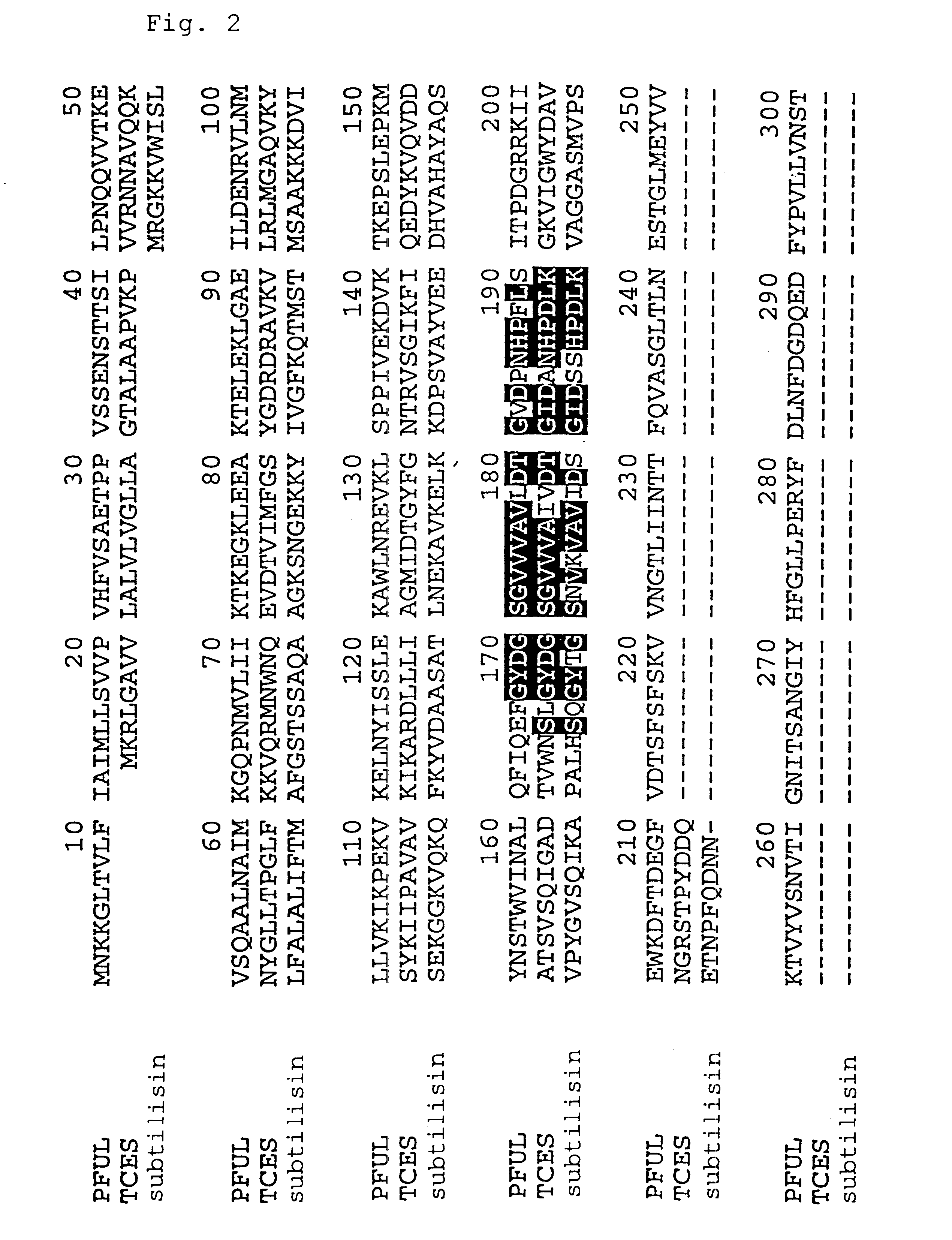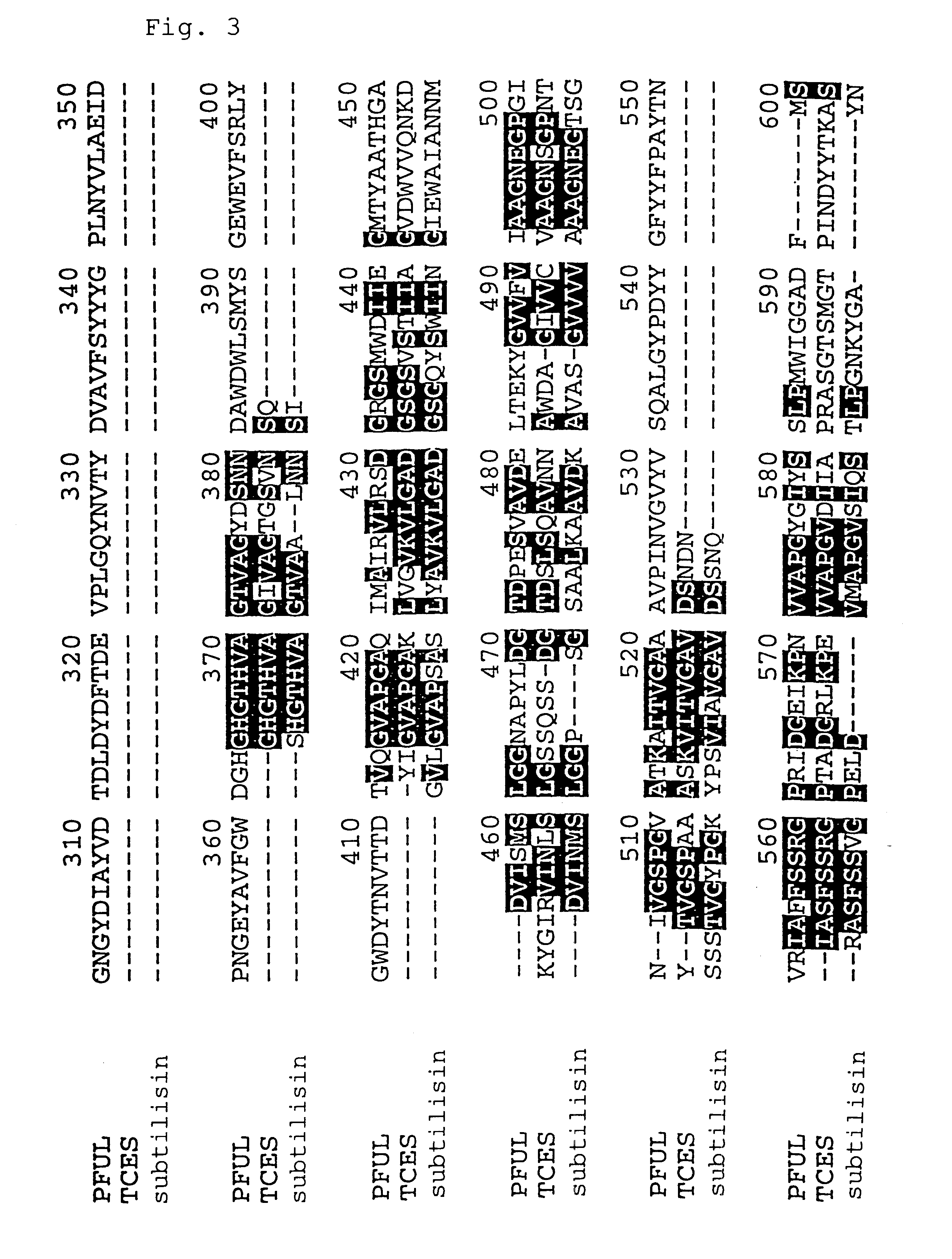Thermostable protease
a technology of protease and protease, which is applied in the field of thermostable protease, can solve the problems of disadvantageous culturing at such high temperature in view of energy cost, the method of industrial production of proteases from hyperthermophiles has problems, and the microorganisms producing these enzymes grow, etc., to achieve the effect of improving the expression level of protease, reducing the cost of production, and improving the efficiency of removal of signal peptid
- Summary
- Abstract
- Description
- Claims
- Application Information
AI Technical Summary
Benefits of technology
Problems solved by technology
Method used
Image
Examples
example 2
(1) Synthesis of Primers for Constructing the Plasmid pNSP1
In order to synthesize primers used to amplify the entire Protease PFUS gene, the plasmid pSNP1 that contains the entire gene was isolated from Bacillus subtilis DB104 / pSNP1 (FERM BP-5634) and the base sequence of the required region was determined. Based on the base sequence, the primer NPF-4 for introducing a BamHI site immediately upstream the initiation codon of the Protease PFUS gene and the primer NPM-1 which hybridizes with the 3' region of the gene and contains a recognition site for SphI were synthesized. The base sequences of the primers NPF-4 and NPM-1 are shown in the SEQ ID NOS:13 and 19 of the Sequence Listing, respectively.
The primers mutRR and mutFR for removing the BamHI site present approximately 1.7 kb downstream from the initiation codon in the Protease PFUS gene were also synthesized. The base sequences of the primers mutRR and mutFR are shown in the SEQ ID NOS:20 and 21 of the Sequence Listing, respecti...
example 3
(1) Cultivation of Bacillus subtilis Transformed with a Plasmid Containing the Protease PFUS Gene and Preparation of a Crude Enzyme Solution
Bacillus subtilis DB104 / pNAPS1, which is Bacillus subtilis DB104 into which the plasmid pNAPS1 containing the Protease PFUS gene was introduced as described in Example 2, was cultured in 2 mL of LB medium (Tryptone 10 g / L, yeast extract 5g / L, NaCl 5g / L, pH 7.2) containing 10 .mu.g / mL of kanamycin at 37.degree. C. for 24 hours. The culture was centrifuged to obtain a culture supernatant (the preparation 1-S) and cells.
The cells were suspended in 100 .mu.L of 50 mM Tris-HCl, pH 7.5 and digested at 37.degree. C. for 45 minutes after an addition of 2 mg of lysozyme (Sigma). The digested sample was heat-treated at 95.degree. C. for 10 minutes, and then a supernatant was collected by centrifugation to obtain a cell-free extract (the preparation 1-L).
Similarly, culture supernatants and cell-free extracts were obtained from Bacillus subtilis DB104 / pSPO1...
example 4
(1) Preparation of Purified Enzyme Preparation of the Mature Protease PFUS
Bacillus subtilis DB104 / pNAPS1 and Bacillus subtilis DB104 / pSPO124.DELTA.C, both of which are Bacillus subtilis DB104 into which the gene for the hyperthermostable protease of the present invention was introduced as described in Example 2, were separately inoculated into 5 mL of LB medium containing 10 .mu.g / mL kanamycin and cultured with shaking at 37.degree. C. for 7 hours. The cultures of 5 mL were inoculated into 500 mL of TM medium (soybean powder 5 g / L, Polypeptone 10 g / L, meat extract 5 g / L, yeast extract 2 g / L, glucose 10 g / L, FeSO.sub.4.multidot.7H.sub.2 O 10 mg / L, MnSO.sub.4.multidot.4H.sub.2 O 10 mg / L, ZnSO.sub.4.multidot.7H.sub.2 O 1 mg / L, pH 7.0) containing 10 .mu.g / mL of kanamycin in 5 L Erlenmeyer flasks and cultured with shaking at 30.degree. C. for 3 days. The resulting cultures were sonicated, heat-treated at 95.degree. C. for 30 minutes, then centrifuged to collect supernatants. Ammonium sul...
PUM
| Property | Measurement | Unit |
|---|---|---|
| temperature | aaaaa | aaaaa |
| temperature | aaaaa | aaaaa |
| molecular weight | aaaaa | aaaaa |
Abstract
Description
Claims
Application Information
 Login to View More
Login to View More - R&D
- Intellectual Property
- Life Sciences
- Materials
- Tech Scout
- Unparalleled Data Quality
- Higher Quality Content
- 60% Fewer Hallucinations
Browse by: Latest US Patents, China's latest patents, Technical Efficacy Thesaurus, Application Domain, Technology Topic, Popular Technical Reports.
© 2025 PatSnap. All rights reserved.Legal|Privacy policy|Modern Slavery Act Transparency Statement|Sitemap|About US| Contact US: help@patsnap.com



